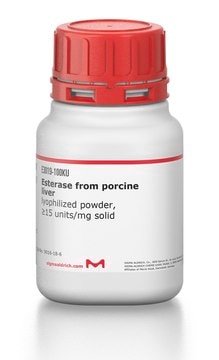The material is indeed considered deacetylated. The molecular weight specification is given in terms of the number of monomeric units (greater than or equal to 400), but it often measures at 2000 units or higher. Recent lots (066K1894, 046K1080, 105K1648, and 065K1306) all have an average molecular weight of approximately 400,000. This is based on a monomer molecular weight of 203 and a degree of polymerization of 2000.
G7753
Glycol chitosan
≥60% (titration), crystalline
Synonym(s):
Glycol chitin, deacetylated
About This Item
Recommended Products
form
crystalline
Quality Level
mol wt
degree of polymerization ≥400
concentration
≥60% (titration)
storage temp.
−20°C
Application
Other Notes
Storage Class Code
11 - Combustible Solids
WGK
WGK 3
Flash Point(F)
Not applicable
Flash Point(C)
Not applicable
Personal Protective Equipment
Choose from one of the most recent versions:
Already Own This Product?
Find documentation for the products that you have recently purchased in the Document Library.
Customers Also Viewed
-
Is the product considered deacetylated and is the 'degree of polymerization' specification given in a number of units?
1 answer-
Helpful?
-
-
What is the degree of substitution for ethylene glycol in the product?
1 answer-
The degree of substitution of ethylene glycol is not determined.
Helpful?
-
-
It states that the degree of polymerization is over 400, but are more than 400 units continuously combined based on the chitosan unit?
1 answer-
The polymerization degree is at minimum is 400. Please review the lot specific Certificate of Analysis for this value: https://www.sigmaaldrich.com/certificates/COFA/G7/G7753/G7753-BULK________SLBW9324__.pdf.
Helpful?
-
-
What is the degree of deacetylation?
1 answer-
This product is considered to be deacetylated. Chitosan is the deacetylated form of chitin. The degree of acetylation is not determined for this product, but is expected to be approximately 90%.
Helpful?
-
-
How is the titration performed?
1 answer-
The titration protocol is proprietary, however it is a colloidal titration method involving the use of potassium polyvinyl sulfate.
Helpful?
-
Active Filters
Our team of scientists has experience in all areas of research including Life Science, Material Science, Chemical Synthesis, Chromatography, Analytical and many others.
Contact Technical Service




